Aircraft Detection Using Phase-Sensitive Optical-Fiber OTDR
Abstract
:1. Introduction
2. Materials and Methods
2.1. Seismic Waves Caused by Airplane Noise
2.2. Phase-Sensitive Optical-Fiber OTDR
2.3. Field Experiment Environment
3. Results
3.1. Time-Domain Analysis
3.2. Frequency-Domain Analysis and Signal Denoising
3.3. Time-Frequency Analysis
4. Discussion
5. Conclusions
Author Contributions
Funding
Institutional Review Board Statement
Informed Consent Statement
Data Availability Statement
Conflicts of Interest
References
- Daolai, C.; Chuijie, Y.; Zufeng, L. Research on aircraft noise and its prevention and control measures. Noise Vib. Control 2005, 25, 47–51. [Google Scholar]
- Weiyang, Q.; Michel, U. Two-dimensional microphone array measurement technique and its experimental study on the noise of aircraft approach landing process. J. Acoust. 2001, 26, 161–188. [Google Scholar]
- Nishie, S.; Akagi, M. Acoustic sound source tracking for a moving object using precise doppler-shift measurement. In Proceedings of the 21st European Signal Processing Conference (EUSIPCO 2013), Marrakech, Morocco, 9–13 September 2013; pp. 1–5. [Google Scholar]
- Kalkan, Y.; Baykal, B. MIMO radar target localization by using Doppler shift measurement. In Proceedings of the 6th European Radar Conference, Rome, Italy, 30 September–2 October 2009; pp. 489–492. [Google Scholar]
- Damarla, T.R.; Ufford, D. Helicopter detection using harmonics and seismic-acoustic coupling. Proc. SPIE 2008, 6963, 69630W. [Google Scholar] [CrossRef]
- Damarla, T. Azimuth & elevation estimation using acoustic array. In Proceedings of the 2010 13th Conference on Information Fusion (FUSION), Edinburgh, UK, 26–29 July 2010; pp. 1–7. [Google Scholar]
- Eibl, E.P.; Lokmer, I.; Bean, C.J.; Akerlie, E. Helicopter location and tracking using seismometer recordings. Geophys. J. Int. 2017, 209, 901–908. [Google Scholar] [CrossRef] [Green Version]
- Meng, H.; Ben-Zion, Y. Characteristics of Airplanes and Helicopters Recorded by a Dense Seismic Array Near Anza California. J. Geophys. Res. Solid Earth 2018, 123, 4783–4797. [Google Scholar] [CrossRef]
- Bao, X.; Chen, L. Recent progress in distributed fiber optic sensors. Sensors 2012, 12, 8601–8639. [Google Scholar] [CrossRef] [PubMed] [Green Version]
- Shi, Y.; Feng, H.; Zeng, Z. A Long Distance Phase-Sensitive Optical Time Domain Reflectometer with Simple Structure and High Locating Accuracy. Sensors 2015, 15, 21957–21970. [Google Scholar] [CrossRef] [Green Version]
- Dou, S.; Lindsey, N.; Wagner, A.M.; Daley, T.M.; Freifeld, B.; Robertson, M.; Peterson, J.; Ulrich, C.; Martin, E.R.; Ajo-Franklin, J.B. Distributed Acoustic Sensing for Seismic Monitoring of the Near Surface: A Traffic-Noise Interferometry Case Study. Sci. Rep. 2017, 7, 11620. [Google Scholar] [CrossRef] [PubMed] [Green Version]
- Liu, H.; Ma, J.; Yan, W.; Liu, W.; Zhang, X.; Li, C. Traffic Flow Detection Using Distributed Fiber Optic Acoustic Sensing. IEEE Access 2018, 6, 68968–68980. [Google Scholar] [CrossRef]
- Liu, H.; Ma, J.; Xu, T.; Yan, W.; Ma, L.; Zhang, X. Vehicle Detection and Classification Using Distributed Fiber Optic Acoustic Sensing. IEEE Trans. Veh. Technol. 2019, 69, 1363–1374. [Google Scholar] [CrossRef]
- Xu, S.; Qin, Z.; Zhang, W.; Xiong, X. Monitoring Vehicles on Highway by Dual-Channel Φ-OTDR. Appl. Sci. 2020, 10, 1839. [Google Scholar] [CrossRef] [Green Version]
- Peng, F.; Duan, N.; Rao, Y.J.; Li, J. Real-Time Position and Speed Monitoring of Trains Using Phase-Sensitive OTDR. IEEE Photonics Technol. Lett. 2014, 26, 2055–2057. [Google Scholar] [CrossRef]
- Timofeev, A.V.; Egorov, D.V.; Denisov, V.M. The rail traffic management with usage of C-OTDR monitoring systems. Int. J. Comput. Electr. Autom. Control Inf. Eng. 2015, 9, 1698–1702. [Google Scholar]
- Timofeev, A.V. Monitoring the railways by means of C-OTDR technology. Int. J. Mech. Aerosp. Ind. Mech. Eng. 2015, 9, 634–637. [Google Scholar]
- Kepak, S.; Cubik, J.; Zavodny, P.; Siska, P.; Davidson, A.; Glesk, I.; Vasinek, V. Fibre optic track vibration monitoring system. Opt. Quantum Electron. 2016, 48, 354. [Google Scholar] [CrossRef] [Green Version]
- Merlo, S.; Malcovati, P.; Norgia, M.; Pesatori, A.; Svelto, C.; Pniov, A.; Zhirnov, A.; Nesterov, E.; Karassik, V. Runways ground monitoring system by phase-sensitive optical-fiber OTDR. In Proceedings of the 2017 IEEE International Workshop on Metrology for AeroSpace (MetroAeroSpace), Padua, Italy, 21–23 June 2017; IEEE: Piscataway, NJ, USA, 2017. [Google Scholar]
- Takeda, N. Fiber optic sensor-based SHM technologies for aerospace applications in Japan. In Proceedings of the 15th International Symposium on: Smart Structures and Materials & Nondestructive Evaluation and Health Monitoring, San Diego, CA, USA, 14–18 March 2008. [Google Scholar]
- Read, I.; Foote, P.; Murray, S. Optical fibre acoustic emission sensor for damage detection in carbon fibre composite structures. Meas. Sci. Technol. 2002, 13, N5–N9. [Google Scholar] [CrossRef]
- Majumder, M.; Gangopadhyay, T.K.; Chakraborty, A.K.; Dasgupta, K.; Bhattacharya, D.K. Fibre Bragg gratings in structural health monitoring—Present status and applications. Sens. Actuators A Phys. 2008, 147, 150–164. [Google Scholar] [CrossRef]
- Guo, H.; Xiao, G.; Mrad, N.; Yao, J. Fiber Optic Sensors for Structural Health Monitoring of Air Platforms. Sensors 2011, 11, 3687–3705. [Google Scholar] [CrossRef] [PubMed]
- Borinski, J.W.; Meller, S.A.; Pulliam, W.J.; Murphy, K.A.; Schetz, J. Aircraft health monitoring using optical fiber sensors. In Proceedings of the Digital Avionics Systems Conference, Philadelphia, PA, USA, 7–13 October 2000; IEEE: Piscataway, NJ, USA, 2000. [Google Scholar]
- Bakhoum, E.G.; Zhang, C.; Cheng, M.H. Real Time Measurement of Airplane Flutter via Distributed Acoustic Sensing. Aerospace 2020, 7, 125. [Google Scholar] [CrossRef]
- Lu, P.; Lalam, N.; Badar, M.; Liu, B.; Chorpening, B.T.; Buric, M.P.; Ohodnicki, P.R. Distributed optical fiber sensing: Review and perspective. Appl. Phys. Rev. 2019, 6, 041302. [Google Scholar] [CrossRef]

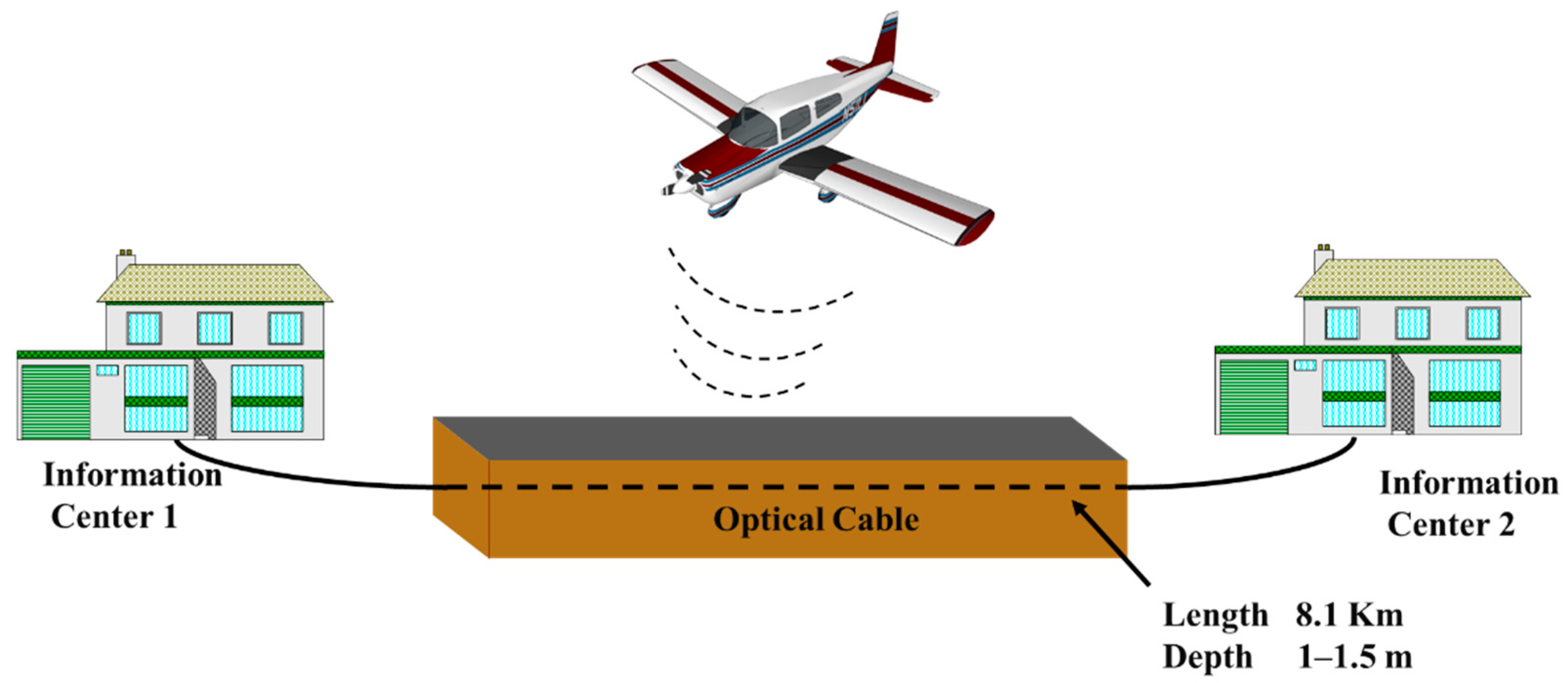
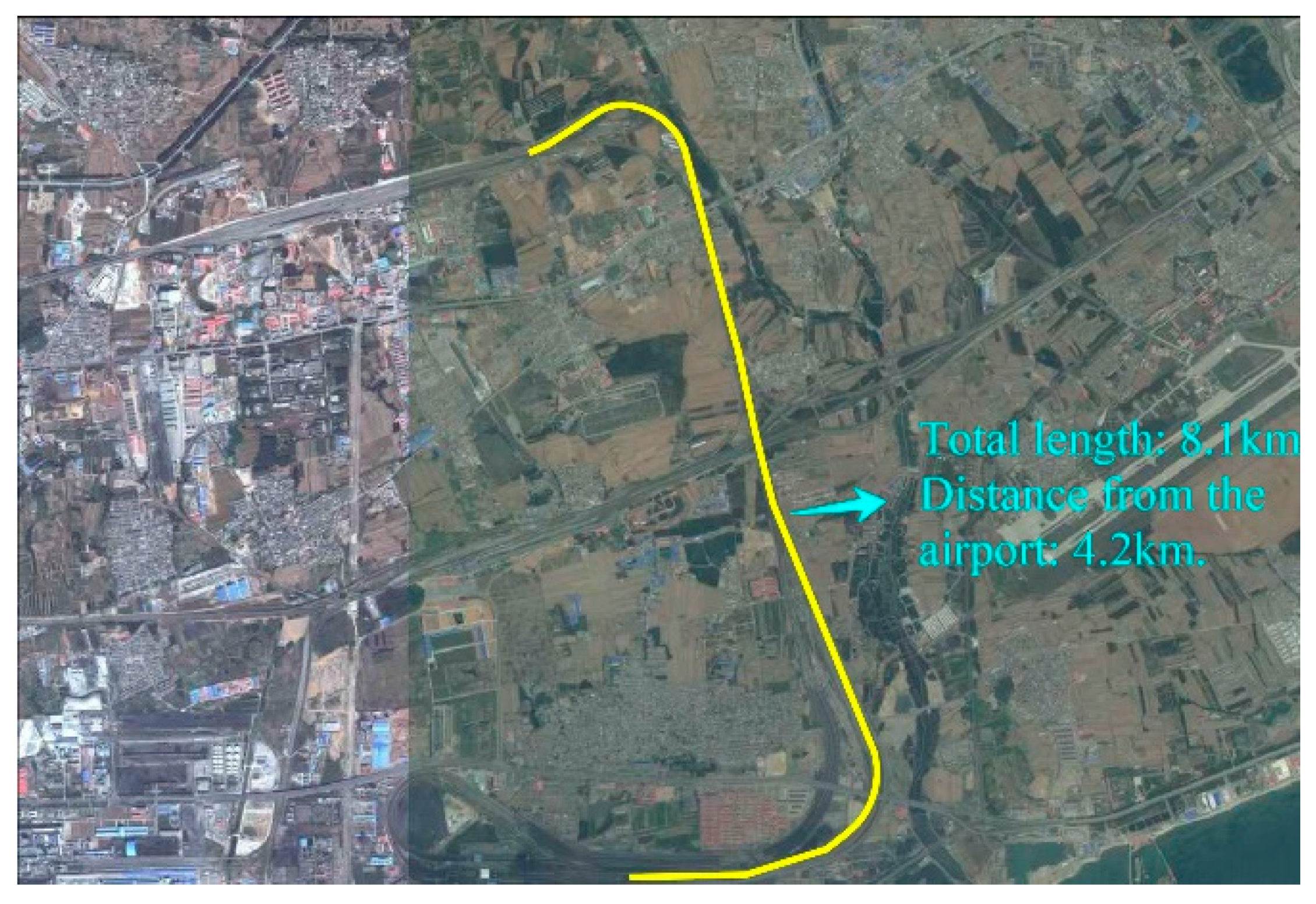
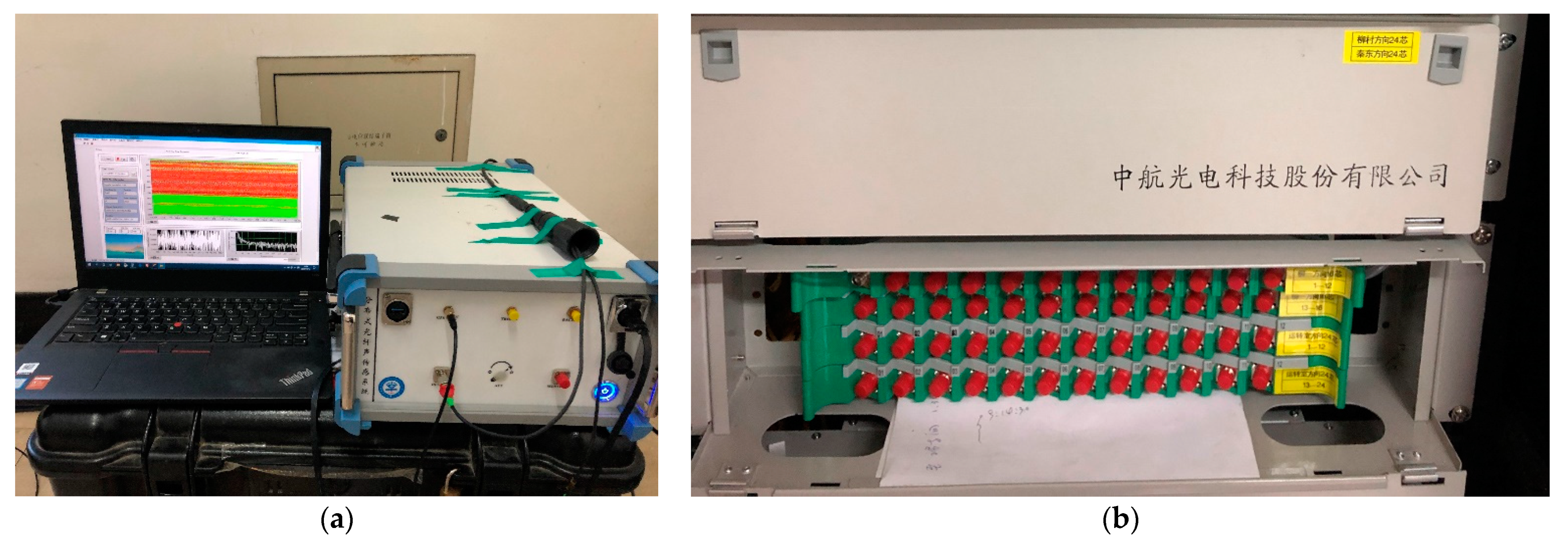
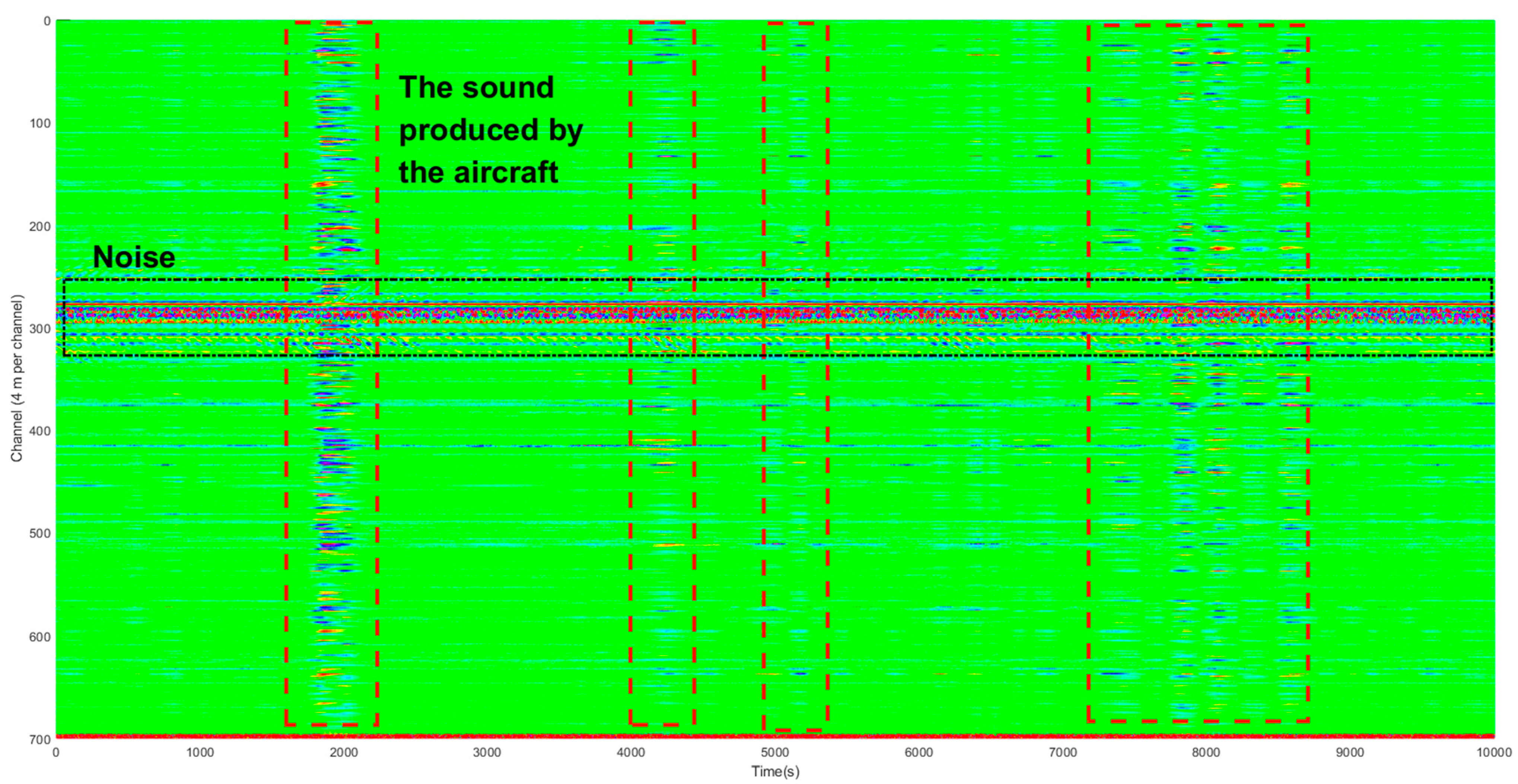
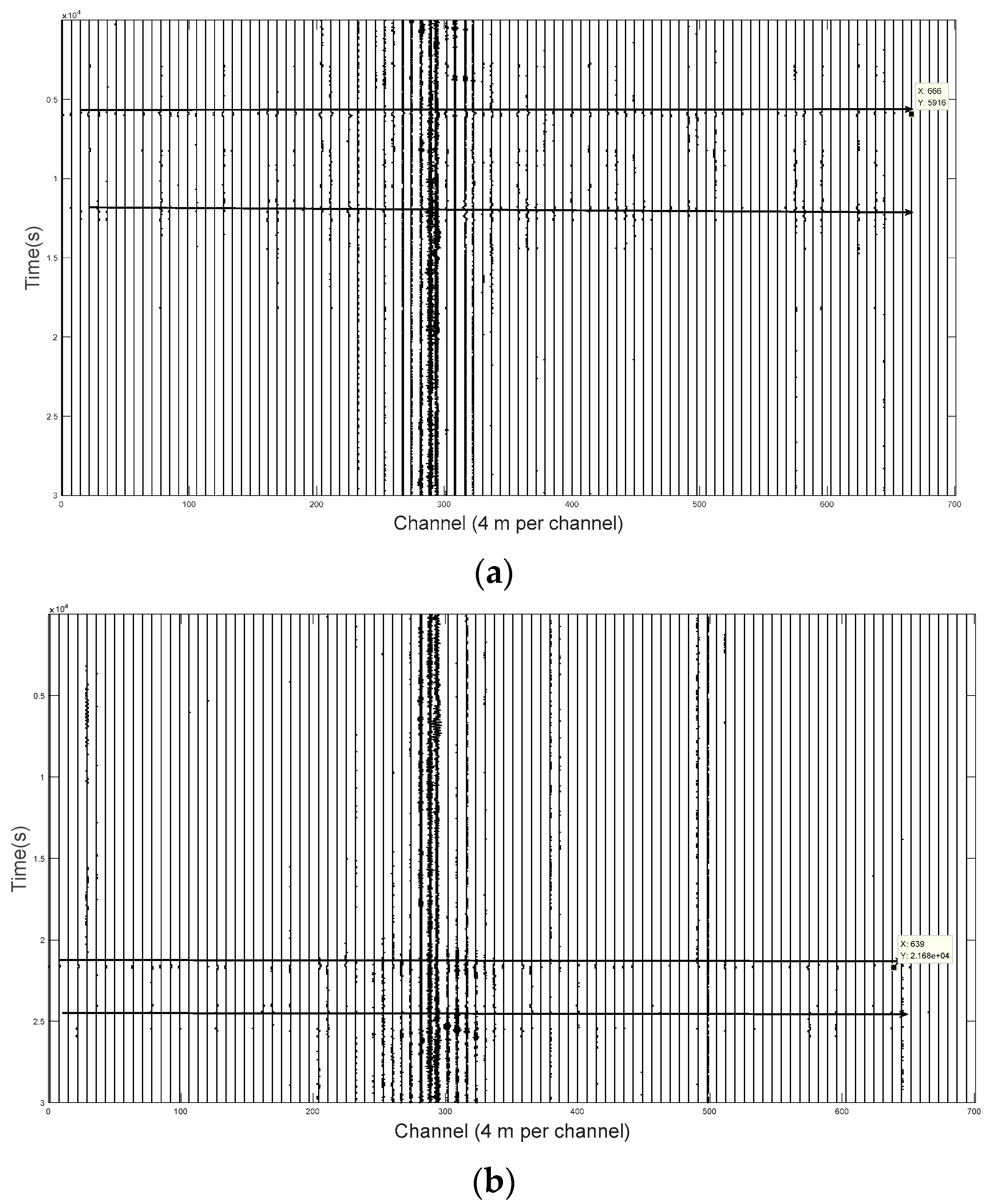
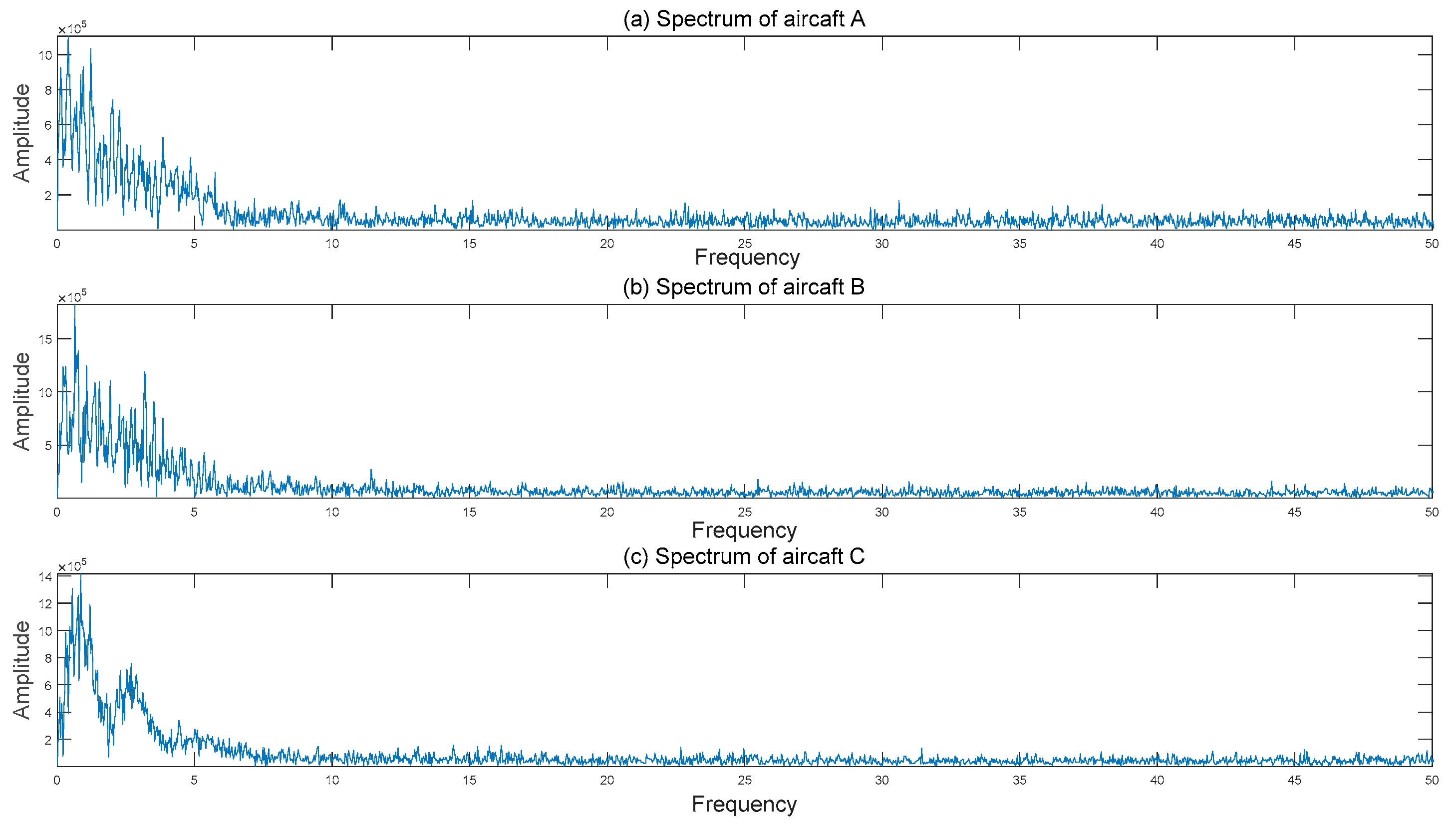

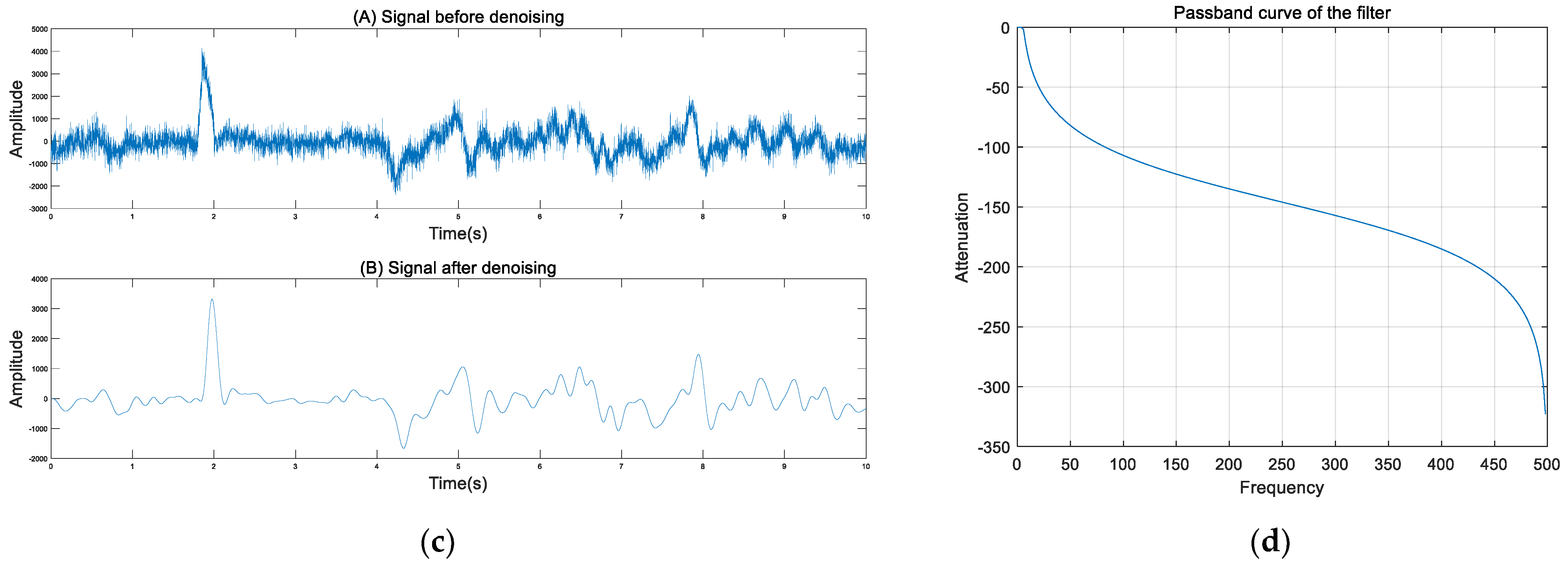
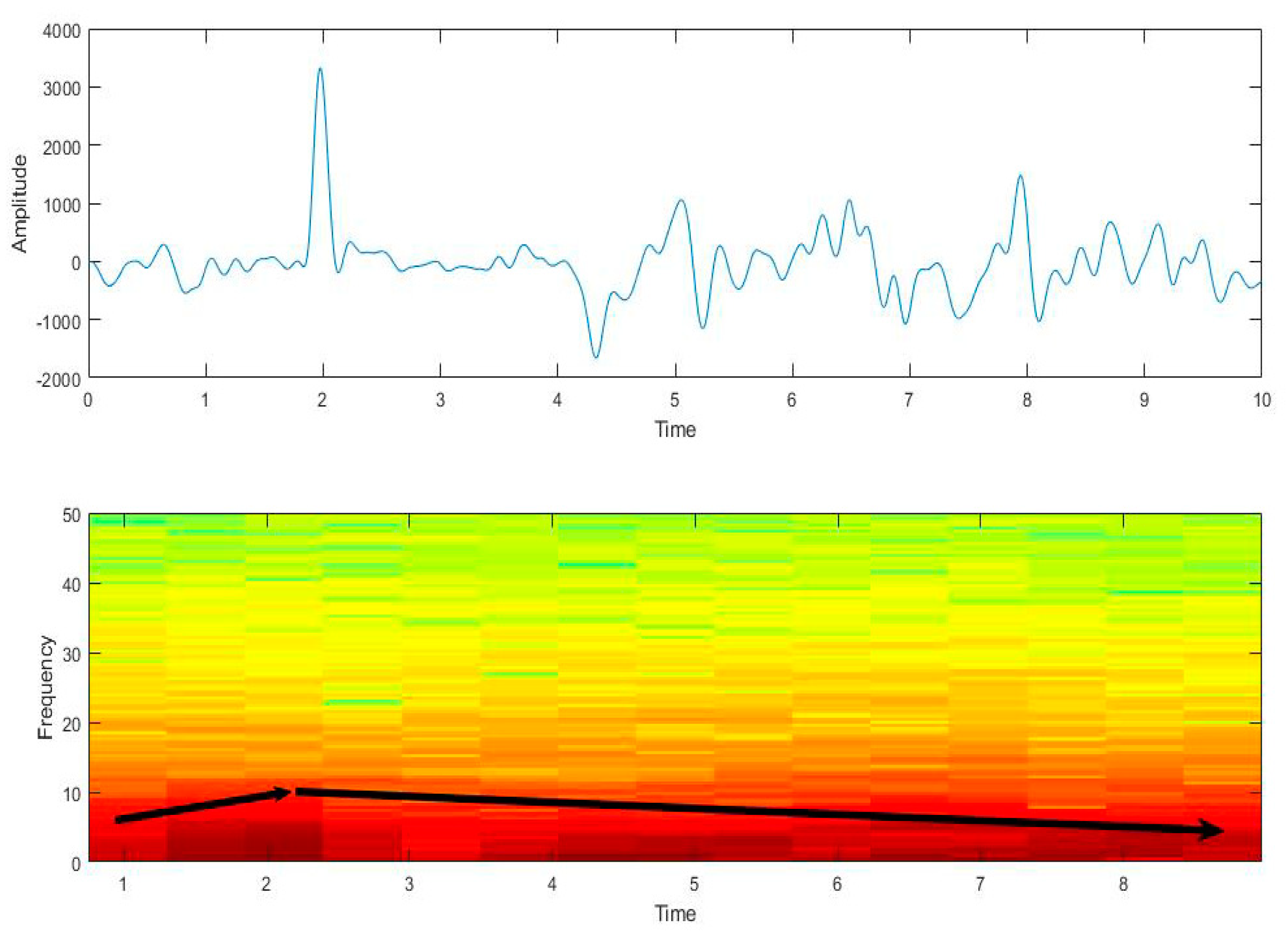
Publisher’s Note: MDPI stays neutral with regard to jurisdictional claims in published maps and institutional affiliations. |
© 2021 by the authors. Licensee MDPI, Basel, Switzerland. This article is an open access article distributed under the terms and conditions of the Creative Commons Attribution (CC BY) license (https://creativecommons.org/licenses/by/4.0/).
Share and Cite
Cai, Y.; Ma, J.; Yan, W.; Zhang, W.; An, Y. Aircraft Detection Using Phase-Sensitive Optical-Fiber OTDR. Sensors 2021, 21, 5094. https://doi.org/10.3390/s21155094
Cai Y, Ma J, Yan W, Zhang W, An Y. Aircraft Detection Using Phase-Sensitive Optical-Fiber OTDR. Sensors. 2021; 21(15):5094. https://doi.org/10.3390/s21155094
Chicago/Turabian StyleCai, Yunpeng, Jihui Ma, Wenfa Yan, Wenyi Zhang, and Yuhang An. 2021. "Aircraft Detection Using Phase-Sensitive Optical-Fiber OTDR" Sensors 21, no. 15: 5094. https://doi.org/10.3390/s21155094
APA StyleCai, Y., Ma, J., Yan, W., Zhang, W., & An, Y. (2021). Aircraft Detection Using Phase-Sensitive Optical-Fiber OTDR. Sensors, 21(15), 5094. https://doi.org/10.3390/s21155094





